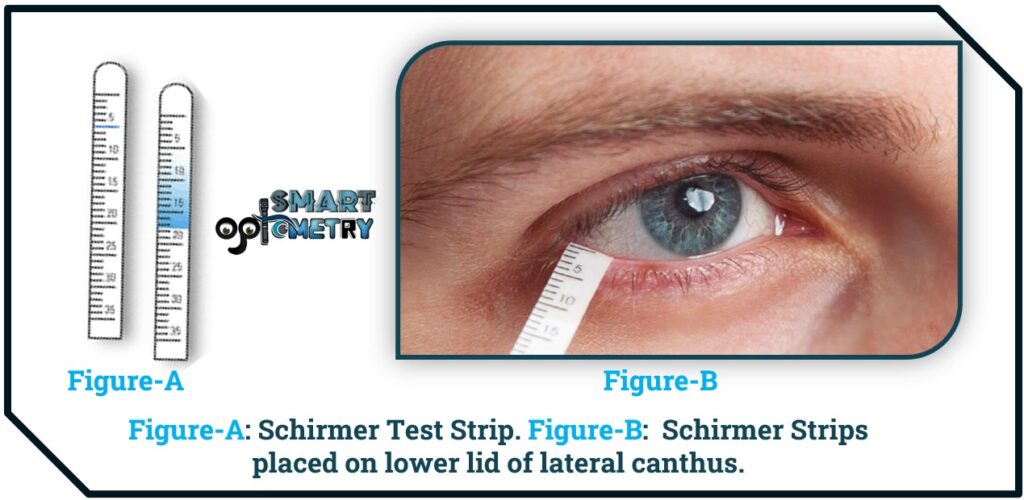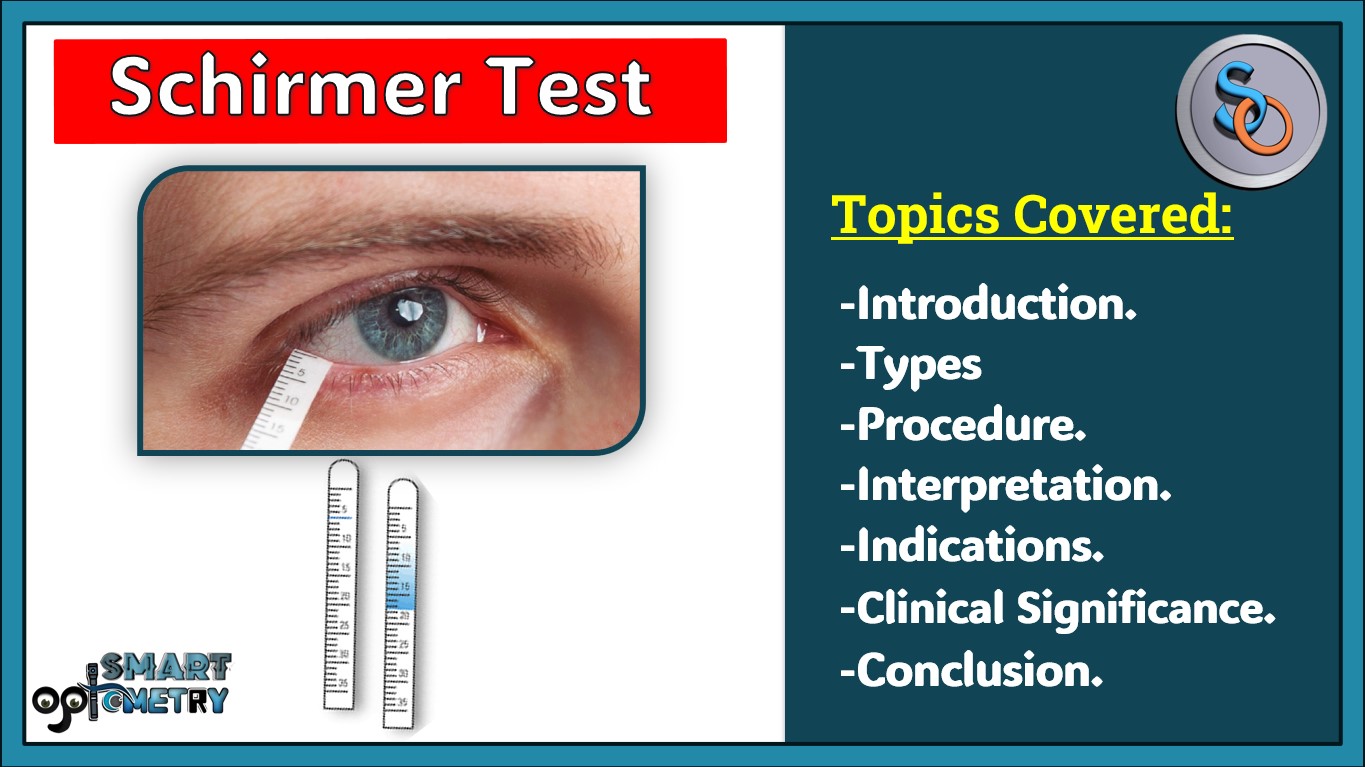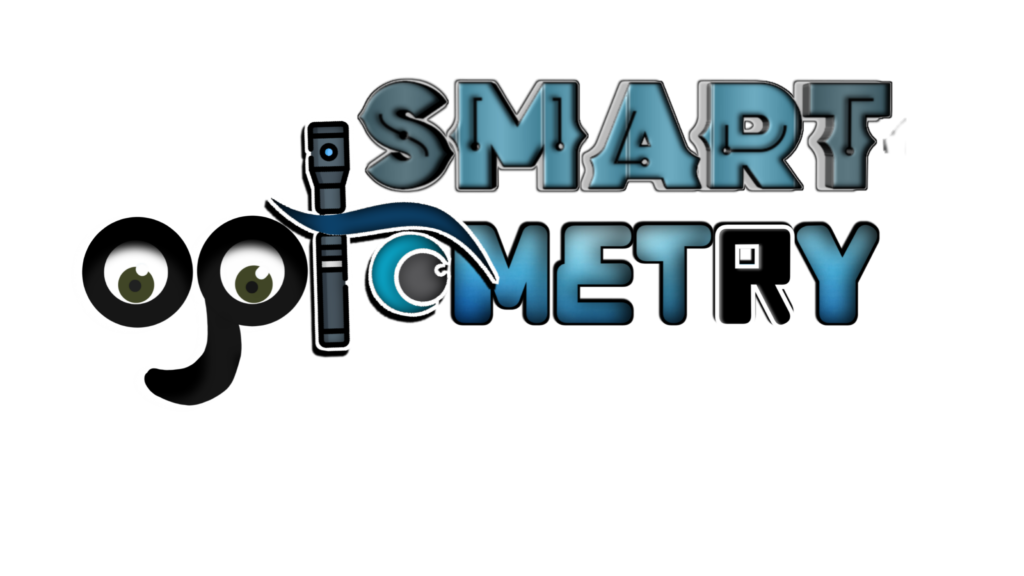What is Schirmer Test?
- Test involves measuring the amount of wetting of a special filter paper (no. 41 Whatman), 5 mm wide and 35 mm long.
- The Schirmer test is performed to measure the quantity of tears produced by the eyes over a specified period, providing valuable information about tear production and assessing for dry eye syndrome.
- It helps in differentiating between aqueous-deficient and evaporative forms of dry eye.
Types:
- There are two types of Schirmer Test:
- A. Schirmer Test-1.
- B. Schirmer Test-2.
A. Schirmer-1 Test:
- No surface anesthetic drops are used.
- It measures basic secretion and reflex secretion.
- Less than 10 mm of wetting after 5 minutes is considered abnormal.
B. Schirmer-2 Test:
- Surface anesthetic drops are used.
- It measures only basic secretion.
- Less than 6mm of wetting after 5 minutes is considered abnormal.

Procedure of Schirmer-1 Test:
- The patient is seated comfortably in an examination chair.
- Schirmer strip is placed inside the lower eyelid of one eye, typically at the lateral canthus (outer corner of the eye).
- The patient is instructed to keep both eyes closed for five minutes, allowing tears to accumulate and wet the strip.
- After the 5min, the strip is removed, and the length of the wet portion (in millimeters) is measured.
Interpretation of Schirmer-1 Test:
- A normal Schirmer test-1 result is typically considered to be greater than 10 millimeters of wetting over five minutes.
- Reduced tear production, indicated by a Schirmer test-1 result of less than 10 millimeters, suggests decreased tear secretion and may indicate dry eye syndrome.
- Schirmer test-1 is an essential component of the dry eye evaluation, providing quantitative information about tear production and guiding treatment decisions.
Procedure of Schirmer-2 Test:
- Anesthetic eye drops are instilled into the eye and excess tears are delicately dried.
- The patient is seated comfortably in an examination chair.
- Schirmer strip is placed inside the lower eyelid of one eye, typically at the lateral canthus (outer corner of the eye).
- The patient is instructed to keep both eyes closed for five minutes, allowing tears to accumulate and wet the strip.
- After the 5min, the strip is removed, and the length of the wet portion (in millimeters) is measured.
Interpretation of Schirmer-2 Test:
- Less than 6mm of wetting after 5 minutes is considered abnormal.
- Schirmer test-2 assesses basal tear production by suppressing reflex tearing with the use of anesthetic drops.
- It provides information about tear production independent of reflex tearing, which can be useful in distinguishing between aqueous-deficient and evaporative forms of dry eye.
- Reduced tear production on Schirmer test-2 suggests inadequate basal tear secretion and may indicate underlying dry eye pathology.
Clinical Significance:
- The Schirmer test is an essential component of the dry eye evaluation, providing quantitative information about tear production.
- It helps in distinguishing between aqueous-deficient and evaporative forms of dry eye, guiding appropriate management strategies.
- The test can be repeated over time to monitor changes in tear production and assess the effectiveness of dry eye treatments, such as artificial tears, punctal plugs, and anti-inflammatory medications.
- Combining the Schirmer test with other diagnostic procedures, such as tear film evaluation, ocular surface staining, and symptom assessment, provides a comprehensive evaluation of dry eye severity and helps tailor individualized treatment plans.
Conclusion:
- In summary, both Schirmer test-1 and Schirmer test-2 are valuable clinical tools for evaluating tear production and diagnosing dry eye syndrome.
- While Schirmer test-1 assesses overall tear production, Schirmer test-2 provides insight into basal tear secretion by suppressing reflex tearing.
- These tests play a crucial role in guiding treatment decisions and monitoring patients with dry eye.
- Check Our Courses: Ophthalmic Instrumentation, Clinical Refraction, Contact Lens, Binocular Vision, Dispensing Optics, MCQs in Optometry
- Download our App “Optometry Notes & MCQs” from Google Play Store.




